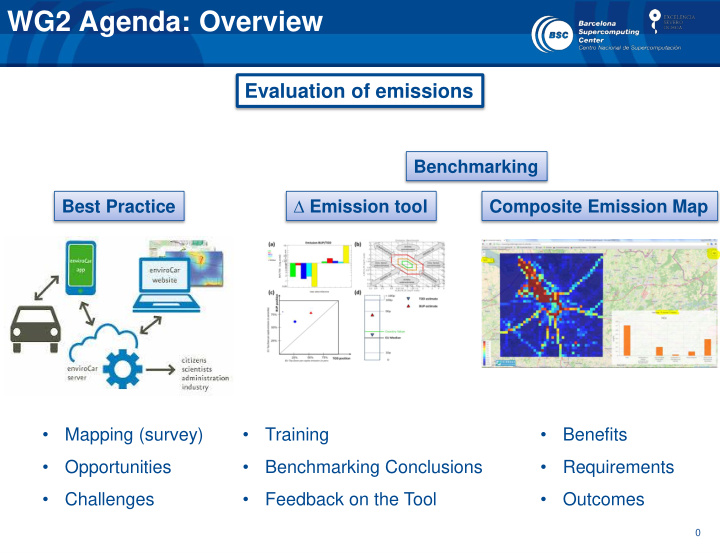



WG2 Agenda: Overview Evaluation of emissions Benchmarking ∆ Emission tool Best Practice Composite Emission Map Best Practice • • • Mapping (survey) Training Benefits • • • Opportunities Benchmarking Conclusions Requirements • • • Challenges Feedback on the Tool Outcomes 0
Good practice guidelines on urban traffic emission compilation FAIRMODE Technical Meeting 27-29 June 2016, Zagreb, Croatia Marc Guevara 1 , Susana López Aparicio 2 , Matthias Vogt 2 , Leonor Tarrasón 2 1 Barcelona Supercomputing Center - Centro Nacional de Supercomputación, Earth Sciences Department, Barcelona, Spain. 2 NILU - Norwegian Institute for Air Research, Urban Environment and Industry, Kjeller, Norway. 1
Urban traffic emissions Road traffic is the emission source that contributes most to air pollution in urban areas Daily PM10 LV Annual NO 2 LV 2
Air Quality Planning Air quality observations Traffic pollution- reduction measures effectiveness Traffic flow Vehicle fleet composition Traffic Emissions EF model Air quality modelling Road Network 3
Current review works 4
Mapping the best practices for urban traffic emissions Adapted from Ejik (2012) and Bedogni (2014) Brower (2014) Automatic Number Plate Floating Car Data Recognition systems Traffic models and Extended Floating Car wireless traffic sensors Data 5 https://envirocar.org/
Overview of participation in the survey • A total of 16 participants • More than 30 cities from 13 different countries 6
General information on your emission inventory 1. For which components do you estimate urban traffic emissions? 2. For which purpose do you estimate urban traffic emissions? 7
Information on activity data 3. What of the following methods do you use to compile traffic volume data? 10 answers: Combination of the 3 methods Calibration Validation 8
Information on activity data 4. What of the following methods do you use to compile speed data? 7 answers: Combination of the 3 methods Calibration Validation 9
Information on activity data 5. What of the following methods do you use to obtain vehicle fleet composition? Cover the diversity of the areas within a city Source of Uncertainty Cover the temporal variation of the fleet 2 week-days ~ 600,000 observations Kolli et al. (2011) 10 André et al. (2014) André et al. (2014)
Emission factor models 6. What of the following emission factor models do you use? In-house EF datasets (based on real-driving tests) Even though the approaches behind COPERT and HBEFA are somewhat different, they are largerly underpinned by the same experimental data (Franco et al., 2012) 11
Emission factor models 7. Do you apply corrections to the emission factors? PEMS, RSD Ratio of on-road emissions to legal limits (NOx Euro6): All cars: 7.1 12 Franco et al. (2014)
Future work 7. Do you plan to change your method to compile activity data in the future? • No (62.5%) • Use of high frequency pollution sensors to estimate traffic volume in locations where emission inventories are poor . • Better integration of models/scales with regional traffic demand models / microsimulation models • Use of FCD to estimate hourly speed data 8. Do you plan to change your emission factor model? • No (50%) • Alternative models for emission computation at microscale level . • EF based on real world measurements (Diesel Euro V, IV categories) 9. Which information would you like to receive before planning any changes? • Quality, accuracy and uncertainty of emission factors • Comparison between methodologies Guidance on and benchmarking of models, Uncertainty, Test cases! 13
Conclusions Vehicle activity data: Traffic models combined with Automatic Traffic Recorders, Manual Counting and Instrumented Vehicles is the most applied approach to obtain traffic volume and speed data FCD : Its use is limited due to: Privacy concerns (private companies own the data) Big data concerns (large amount of data to process) Limited Volume (need for extrapolation) Vehicle fleet composition: Automatic Number Plate Recognition data Official registration data is commonly used Automatic Number Plate Recognition Systems is gaining ground Emission Factor Models: COPERT and HBEFA are the leading EU models. Measurement based corrections (PEMS, RSD) applied to reduce associated uncertainty 14
www.bsc.es Masterplan for Masdar City, Abu Dhabi, which keeps cars out of the centre Thank you! For further information please contact marc.guevara@bsc.es
FCD: Challenges and Opportunities Challenges: Multiple information sources (not free) Navigation and Car Insurance Companies Specific fleets (e.g. Taxis) Privacy concerns (restricted information) Fuel type, Euro category Big data concerns (large amount of data to process) 3,000 cars (1 week information) 500MB Opportunities: Information based on real-world data NRT emission modelling Detection of potential modelling sites (hot spots) 16
Other Sector to Focus On: Residential Combustion Use of wood and other biomass in residential sector enhanced by: • National GHG strategies and targets for renewable energy • Increase during the economic crisis of other fuel prices (e.g. fuel oil) Lack of regulation of small combustion appliances at EU level (Eco-design Directive) 17
Recommend
More recommend